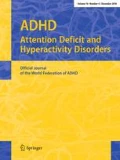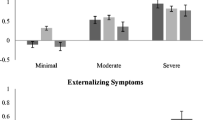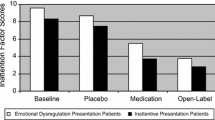Abstract
There is debate regarding the dimensional versus categorical nature of attention-deficit/hyperactivity disorder (ADHD). This study utilized confirmatory factor analysis to examine this issue. ADHD symptoms rated on interviews and rating scales from a large sample of individuals (ages 3–17, 74 % male, 75 % Caucasian) with ADHD were examined (n = 242). Four potential factor structures were tested to replicate prior findings in a sample with a wide age range and included only participants who met DSM-IV-TR diagnostic criteria for ADHD. Correlations with executive function measures were performed to further assess the separability and validity of the derived factors. The data support a bifactor model with a general ADHD factor and two specific factors, inattention and hyperactivity/impulsivity. Importantly, the individual factors were also differentially correlated with executive functioning measures. This study adds to a growing literature suggesting both a general component to ADHD, as well as dimensional traits of inattention and hyperactivity/impulsivity, associated with distinct executive functioning profiles. The presence of a general underlying factor contraindicates separating the inattentive and combined subtypes of ADHD into distinct disorders.

Similar content being viewed by others
References
Adams ZW, Derefinko KJ, Milich R, Fillmore MT (2008) Inhibitory functioning across ADHD subtypes: recent findings, clinical implications, and future directions. Dev Disabil Res Rev 14(4):268–275. doi:10.1002/ddrr.37
American Psychiatric Association (2000) Diagnostic and statistical manual of mental disorders. 4th ed., text rev edn. American Psychiatric Association, Washington, DC
Baeyens D, Roeyers H, Walle JV (2006) Subtypes of attention-deficit/hyperactivity disorder (ADHD): distinct or related disorders across measurement levels? Child Psychiatry Hum Dev 36(4):403–417. doi:10.1007/s10578-006-0011-z
Barbaresi WJ, Katusic SK, Colligan RC, Weaver AL, Leibson CL, Jacobsen SJ (2006) Long-term stimulant medication treatment of attention-deficit/hyperactivity disorder: results from a population-based study. J Dev Behav Pediatr 27(1):1–10
Canu WH, Carlson CL (2003) Differences in heterosocial behavior and outcomes of ADHD-symptomatic subtypes in a college sample. J Atten Disord 6(3):123–133
Canu WH, Carlson CL (2007) Rejection sensitivity and social outcomes of young adult men with ADHD. J Atten Disord 10(3):261–275
Carlson CL, Shin M, Booth JE (1999) The case for DSM-IV subtypes in ADHD. Ment Retard Dev Disabil Res Rev 5:199–206
Chhabildas N, Pennington BF, Willcutt EG (2001) A comparison of the neuropsychological profiles of the DSM-IV subtypes of ADHD. J Abnorm Child Psychol 29(6):529–540
Chou WJ, Chou MC, Tzang RF, Hsu YC, Gau SS, Chen SJ, Wu YY, Huang YF, Liang HY, Cheng H (2009) Better efficacy for the osmotic release oral system methylphenidate among poor adherents to immediate-release methylphenidate in the three ADHD subtypes. Psychiatry Clin Neurosci 63(2):167–175
Collett BR, Crowley SL, Gimpel GA, Greenson JN (2000) The factor structure of DSM-IV attention deficit-hyperactivity symptoms: a confirmatory factor analysis of the ADHD-SRS. J Psychoeduc Assess 18:361–373
Covey LS, Manubay J, Jiang H, Nortick M, Palumbo D (2008) Smoking cessation and inattention or hyperactivity/impulsivity: a post hoc analysis. Nicotine Tob Res 10(12):1717–1725
Derefinko KJ, Adams ZW, Milich R, Fillmore MT, Lorch EP, Lynam DR (2008) Response style differences in the inattentive and combined subtypes of attention-deficit/hyperactivity disorder. J Abnorm Child Psychol 36(5):745–758. doi:10.1007/s10802-007-9207-3
Dumenci L, McConaughy SH, Achenbach TM (2004) A hierarchical three-factor model of inattention-hyperactivity-impulsivity derived from the attention problems syndrome of the Teacher’s Report Form. Sch Psychol Rev 33(2):287–301
DuPaul GJ, Power TJ, Anastopoulos AD, Reid R (1998) ADHD Rating Scale-IV: checklists, norms, and clinical interpretation. Guilford Press, New York
Faraone SV, Biederman J, Weber W, Russell RL (1998) Psychiatric, neuropsychological, and psychosocial features of DSM-IV subtypes of attention-deficit/hyperactivity disorder: results from a clinically referred sample. J Am Acad Child Adolesc Psychiatry 37(2):185–193. doi:10.1097/00004583-199802000-00011
Fillmore MT, Milich R, Lorch EP (2009) Inhibitory deficits in children with attention-deficit/hyperactivity disorder: intentional versus automatic mechanisms of attention. Dev Psychopathol 21(2):539–554
Gau SS, Shang CY, Liu SK, Lin CH, Swanson JM, Liu YC, Tu CL (2008) Psychometric properties of the Chinese version of the Swanson, Nolan, and Pelham, version IV scale—parent form. Int J Methods Psychiatr Res 17(1):35–44. doi:10.1002/mpr.237
Gaub M, Carlson CL (1997) Gender differences in ADHD: a meta-analysis and critical review. J Am Acad Child Adolesc Psychiatry 36(8):1036–1045
Gibbins C, Toplak ME, Flora DB, Weiss MD, Tannock R (2011) Evidence for a general factor model of ADHD in adults. J Atten Disord. doi:10.1177/1087054711416310
Gioia GA, Isquith PK, Guy SC, Kenworthy L (2000) Behavior rating inventory of executive function professional manual. Psychological Assessment Resources, Inc., Lutz
Glutting JJ, Youngstrom EA, Watkins MW (2005) ADHD and college students: exploratory and confirmatory factor structures with student and parent data. Psychol Assess 17(1):44–55. doi:10.1037/1040-3590.17.1.44
Gomez R, Harvey J, Quick C, Scharer I, Harris G (1999) DSM-IV AD/HD: confirmatory factor models, prevalence, and gender and age differences based on parent and teacher ratings of Australian primary school children. J Child Psychol Psychiatry 40(2):265–274
Harman HH (1976) Modern factor analysis, 3rd revised edn. The University of Chicago Press, Chicago
Hart EL, Lahey BB, Loeber R, Applegate B, Frick PJ (1995) Developmental change in attention-deficit hyperactivity disorder in boys: a four-year longitudinal study. J Abnorm Child Psychol 23(6):729–749
Hinshaw SP (2001) Is the inattentive type of ADHD a separate disorder? Clin Psychol-Sci Pract 8(4):498–501
Hoare P, Remschmidt H, Medori R, Ettrich C, Rothenberger A, Santosh P, Schmit M, Spender Q, Tamhne R, Thompson M, Tinline C, Trott GE (2005) 12-month efficacy and safety of OROS MPH in children and adolescents with attention-deficit/hyperactivity disorder switched from MPH. Eur Child Adolesc Psychiatry 14(6):305–309
Houghton S, Douglas G, West J, Whiting K, Wall M, Langsford S, Powell L, Carroll A (1999) Differential patterns of executive function in children with attention- deficit hyperactivity disorder according to gender and subtype. J Child Neurol 14(12):801–805
Hudziak JJ, Heath AC, Madden PF, Reich W, Bucholz KK, Slutske W, Bierut LJ, Neuman RJ, Todd RD (1998) Latent class and factor analysis of DSM-IV ADHD: a twin study of female adolescents. J Am Acad Child Adolesc Psychiatry 37:848–857
Hurtig T, Ebeling H, Taanila A, Miettunen J, Smalley SL, McGough JJ, Loo SK, Jarvelin MR, Moilanen IK (2007) ADHD symptoms and subtypes: relationship between childhood and adolescent symptoms. J Am Acad Child Adolesc Psychiatry 46(12):1605–1613. doi:10.1097/chi.0b013e318157517a
Kaufman J, Birmaher B, Brent D, Rao U, Flynn C, Moreci P (1997) Schedule for affective disorders and schizophrenia for school-age children-present and lifetime version (K-SADS-PL): initial reliability and validity data. J Am Acad Child Adolesc Psychiatry 36:980–987
Kline RB (1998) Principles and practice of structural equation modeling. Guilford Press, New York
Kopecky H, Chang HT, Klorman R, Thatcher JE, Borgstedt AD (2005) Performance and private speech of children with attention-deficit/hyperactivity disorder while taking the Tower of Hanoi test: effects of depth of search, diagnostic subtype, and methylphenidate. J Abnorm Child Psychol 33(5):625–638
Lahey BB, Pelham WE, Schaughency EA, Atkins MS, Murphy HA, Hynd G, Russo M, Hartdagen S, Lorys-Vernon A (1988) Dimensions and types of attention deficit disorder. J Am Acad Child Adolesc Psychiatry 27(3):330–335. doi:10.1097/00004583-198805000-00011
Lahey BB, Pelham WE, Stein MA, Loney J, Trapani C, Nugent K, Kipp H, Schmidt E, Lee S, Cale M, Gold E, Hartung CM, Willcutt E, Baumann B (1998) Validity of DSM-IV attention-deficit/hyperactivity disorder for younger children. J Am Acad Child Adolesc Psychiatry 37(7):695–702
Lahey BB, Pelham WE, Loney J, Lee SS, Willcutt E (2005) Instability of the DSM-IV subtypes of ADHD from preschool through elementary school. Arch Gen Psychiatry 62(8):896–902. doi:10.1001/archpsyc.62.8.896
Larsson H, Lichtenstein P, Larsson JO (2006) Genetic contributions to the development of ADHD subtypes from childhood to adolescence. J Am Acad Child Adolesc Psychiatry 45(8):973–981
Martel M, Nikolas M, Nigg JT (2007) Executive function in adolescents with ADHD. J Am Acad Child Adolesc Psychiatry 46(11):1437–1444. doi:10.1097/chi.0b013e31814cf953
Martel MM, von Eye A, Nigg JT (2010) Revisiting the latent structure of ADHD: is there a ‘g’ factor? J Child Psychol Psychiatry 51(8):905–914. doi:10.1111/j.1469-7610.2010.02232.x
Mayes SD, Calhoun SL, Chase GA, Mink DM, Stagg RE (2009) ADHD subtypes and co-occurring anxiety, depression, and oppositional-defiant disorder: differences in Gordon diagnostic system and Wechsler working memory and processing speed index scores. J Atten Disord 12(6):540–550. doi:10.1177/1087054708320402
McGoey KE, DuPaul GJ, Haley E, Shelton TL (2007) Parent and teacher ratings of attention-deficit/hyperactivity disorder in preschool: the ADHD Rating Scale-IV Preschool Version. J Psychopathol Behav 29:269–276
Milich R, Balentine AC, Lynam DR (2001) ADHD combined type and ADHD predominantly inattentive type are distinct and unrelated disorders. Clin Psychol Sci Pract 8:463–488
Morgan AE, Hynd GW, Riccio CA, Hall J (1996) Validity of DSM-IV ADHD predominantly inattentive and combined types: relationship to previous DSM diagnoses/subtype differences. J Am Acad Child Adolesc Psychiatry 35(3):325–333. doi:10.1097/00004583-199603000-00014
Murphy KR, Barkley RA, Bush T (2002) Young adults with attention deficit hyperactivity disorder: subtype differences in comorbidity, educational, and clinical history. J Nerv Ment Disord 190(3):147–157
Muthén LK, Muthén BO (1998–2010) Mplus user’s guide, 6th edn. Muthén & Muthén, Los Angeles
Nigg JT, Blaskey LG, Huang-Pollock CL, Rappley MD (2002) Neuropsychological executive functions and DSM-IV ADHD subtypes. J Am Acad Child Adolesc Psychiatry 41(1):59–66
Nigg JT, Tannock R, Rohde LA (2010) What is to be the fate of ADHD subtypes? An introduction to the special section on research on the ADHD subtypes and implications for the DSM-V. J Clin Child Adolesc Psychol 39(6):723–725. doi:10.1080/15374416.2010.517171
Pasini A, Paloscia C, Alessandrelli R, Porfirio MC, Curatolo P (2007) Attention and executive functions profile in drug naive ADHD subtypes. Brain Dev 29(7):400–408
Pillow DR, Pelham WE Jr, Hoza B, Molina BS, Stultz CH (1998) Confirmatory factor analyses examining attention deficit hyperactivity disorder symptoms and other childhood disruptive behaviors. J Abnorm Child Psychol 26(4):293–309
Proctor BE, Prevatt F (2009) Confirming the factor structure of attention-deficit/hyperactivity disorder symptoms in college students using student and parent data. J Learn Disabil 42(3):250–259. doi:10.1177/0022219408331043
Ranby KW, Boynton MH, Kollins SH, McClernon FJ, Yang C, Fuemmeler BF (2012) Understanding the phenotypic structure of adult retrospective ADHD symptoms during childhood in the United States. J Clin Child Adolesc Psychol 41(3):261–274. doi:10.1080/15374416.2012.654465
Rasmussen ER, Todd RD, Neuman RJ, Heath AC, Reich W, Rohde LA (2002) Comparison of male adolescent-report of attention-deficit/hyperactivity disorder (ADHD) symptoms across two cultures using latent class and principal components analysis. J Child Psychol Psychiatry 43(6):797–805
Riccio CA, Homack S, Jarratt KP, Wolfe ME (2006) Differences in academic and executive function domains among children with ADHD predominantly inattentive and combined types. Arch Clin Neuropsychol 21(7):657–667. doi:10.1016/j.acn.2006.05.010
Rohde LA, Barbosa G, Polanczyk G, Eizirik M, Rasmussen ER, Neuman RJ, Todd RD (2001) Factor and latent class analysis of DSM-IVADHD symptoms in a school sample of Brazilian adolescents. J Am Acad Child Adolesc Psychiatry 40(6):711–718. doi:10.1097/00004583-200106000-00017
Satorra A, Bentler PM (2001) A scaled difference Chi-square test statistic for moment structure analysis. Psychometrika 66:507–514
Solanto MV, Pope-Boyd SA, Tryon WW, Stepak B (2009) Social functioning in predominantly inattentive and combined subtypes of children with ADHD. J Atten Disord 13(1):27–35
Span SA, Earleywine M, Strybel TJ (2002) Confirming the factor structure of attention deficit hyperactivity disorder symptoms in adult, nonclinical samples. J Psychopathol Behav 24:129–136
Sprafkin J, Gadow KD, Weiss MD, Schneider J, Nolan EE (2007) Psychiatric comorbidity in ADHD symptom subtypes in clinic and community adults. J Atten Disord 11(2):114–124
Stawicki JA, Nigg JT, von Eye A (2006) Family psychiatric history evidence on the nosological relations of DSM-IV ADHD combined and inattentive subtypes: new data and meta-analysis. J Child Psychol Psychiatry 47(9):935–945
Stein MA, Sarampote CS, Waldman ID, Robb AS, Conlon C, Pearl PL, Black DO, Seymour KE, Newcorn JH (2003) A dose-response study of OROS methylphenidate in children with attention-deficit/hyperactivity disorder. Pediatrics 112(5):e404
Sumner CR (2010) New tool for objective assessment of ADHD: the Quotient® ADHD system. ADHD Rep 18(5):6–9
Tamm L (2009) Attention deficit hyperactivity disorder. In: Squire LR (ed) New encyclopedia of neuroscience. Academic Press, Oxford, pp 617–624
Todd RD, Huang H, Todorov AA, Neuman RJ, Reiersen AM, Henderson CA, Reich WC (2008) Predictors of stability of attention-deficit/hyperactivity disorder subtypes from childhood to young adulthood. J Am Acad Child Adolesc Psychiatry 47(1):76–85. doi:10.1097/chi.0b013e31815a6aca
Toplak ME, Bucciarelli SM, Jain U, Tannock R (2009a) Executive functions: performance-based measures and the behavior rating inventory of executive function (BRIEF) in adolescents with attention deficit/hyperactivity disorder (ADHD). Child Neuropsychol 15(1):53–72. doi:10.1080/09297040802070929
Toplak ME, Pitch A, Flora DB, Iwenofu L, Ghelani K, Jain U, Tannock R (2009b) The unity and diversity of inattention and hyperactivity/impulsivity in ADHD: evidence for a general factor with separable dimensions. J Abnorm Child Psychol 37(8):1137–1150. doi:10.1007/s10802-009-9336-y
Toplak ME, Sorge GB, Flora DB, Chen W, Banaschewski T, Buitelaar J, Ebstein R, Eisenberg J, Franke B, Gill M, Miranda A, Oades RD, Roeyers H, Rothenberger A, Sergeant J, Sonuga-Barke E, Steinhausen HC, Thompson M, Tannock R, Asherson P, Faraone SV (2012) The hierarchical factor model of ADHD: invariant across age and national groupings? J Child Psychol Psychiatry 53(3):292–303. doi:10.1111/j.1469-7610.2011.02500.x
Valo S, Tannock R (2010) Diagnostic instability of DSM-IV ADHD subtypes: effects of informant source, instrumentation, and methods for combining symptom reports. J Clin Child Adolesc Psychol 39(6):749–760. doi:10.1080/15374416.2010.517172
Volk HE, Todorov AA, Hay DA, Todd RD (2009) Simple identification of complex ADHD subtypes using current symptom counts. J Am Acad Child Adolesc Psychiatry 48(4):441–450. doi:10.1097/CHI.0b013e31819996ba
Weiss M, Worling D, Wasdell M (2003) A chart review study of the inattentive and combined types of ADHD. J Atten Disord 7(1):1–9
Willcutt EG, Doyle AE, Nigg JT, Faraone SV, Pennington BF (2005) Validity of the executive function theory of attention-deficit/hyperactivity disorder: a meta-analytic review. Biol Psychiatry 57(11):1336–1346
Willcutt EG, Nigg JT, Pennington BF, Solanto MV, Rohde LA, Tannock R, Loo SK, Carlson CL, McBurnett K, Lahey BB (2012) Validity of DSM-IV attention deficit/hyperactivity disorder symptom dimensions and subtypes. J Abnorm Psychol. doi:10.1037/a0027347
Willoughby MT, Pek J, Greenberg MT (2012) Parent-reported attention deficit/hyperactivity symptomatology in preschool-aged children: factor structure, developmental change, and early risk factors. J Abnorm Child Psychol. doi:10.1007/s10802-012-9641-8
Wolraich ML, Hannah JN, Pinnock TY, Baumgaertel A, Brown J (1996) Comparison of diagnostic criteria for attention-deficit hyperactivity disorder in a county-wide sample. J Am Acad Child Adolesc Psychiatry 35(3):319–324. doi:10.1097/00004583-199603000-00013
Acknowledgments
We are grateful for funding from the Sparrow Foundation which supported data collection and data analysis. The authors would like to thank Chad Barnes for his work on database development, as well as all of the parents and youth who participated. The authors have no financial relationships to disclose, with the exception of Dr. Hughes who receives funding from NIMH (R34MH075762) and is a consultant for Biobehavioral Diagnostics, Inc.
Conflict of interest
The authors declare that they have no conflict of interest.
Author information
Authors and Affiliations
Corresponding author
Rights and permissions
About this article
Cite this article
Smith, L.C., Tamm, L., Hughes, C.W. et al. Separate and overlapping relationships of inattention and hyperactivity/impulsivity in children and adolescents with attention-deficit/hyperactivity disorder. ADHD Atten Def Hyp Disord 5, 9–20 (2013). https://doi.org/10.1007/s12402-012-0091-5
Received:
Accepted:
Published:
Issue Date:
DOI: https://doi.org/10.1007/s12402-012-0091-5




